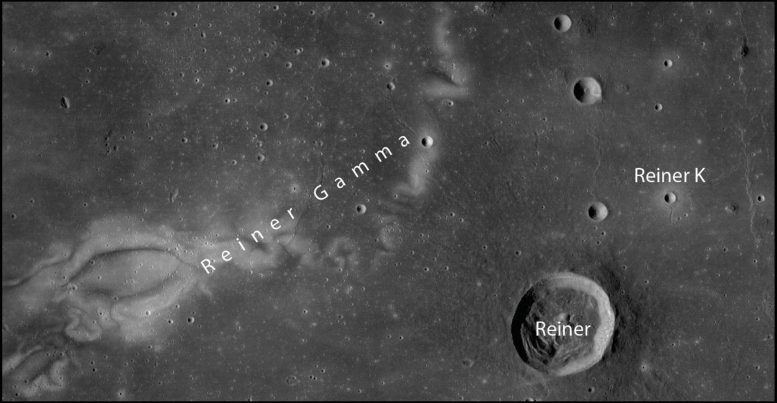
Scientists have discovered anomalous rocks on the Moon with unique dust properties that change how sunlight is reflected, suggesting new geological insights and potential magnetic anomalies. The meter-high rocks discovered in the work are located near the Reiner K crater in the “Reiner Gamma” region, which has a magnetic anomaly. Credit: NASA LRO/NAC
A research group examines the interplay between dust and large rocks, uncovering potentially anomalous stones.
The surface of our Moon is almost completely covered in dust. Unlike on Earth, this lunar dust is not smoothed by wind or weather, retaining its sharp edges and possessing an electrostatic charge. This dust has been studied since the Apollo era at the end of the 1960s.
Now, an international research team led by Dr. Ottaviano Rüsch from the University of Münster has for the first time discovered anomalous meter-sized rocks on the lunar surface that are covered in dust and presumably exhibit unique properties – such as magnetic anomalies. The scientists’ most important finding is that only very few boulders on the Moon have a layer of dust with very special reflective properties.
For example, the dust on these newly discovered boulders reflects sunlight differently than on previously known rocks. These new findings help scientists to understand the processes that form and change the lunar crust. The results of the study have been published in the Journal of Geophysical Research – Planets.
Lunar Magnetic Anomalies and Reflective Properties
It is known that there are magnetic anomalies on the lunar surface, particularly near a region called Reiner Gamma. However, the question of whether rocks can be magnetic has never been investigated. “Current knowledge of the Moon’s magnetic properties is very limited, so these new rocks will shed light on the history of the Moon and its magnetic core,” says Ottaviano Rüsch from the ‘Institut für Planetologie’, categorizing the discovery.
“For the first time, we have investigated the interactions of dust with rocks in the Reiner Gamma region – more precisely, the variations in the reflective properties of these rocks. For example, we can deduce to what extent and in which direction the sunlight is reflected by these large rocks.”
The images were taken by NASA’s Lunar Reconnaissance Orbiter spacecraft, which orbits the Moon.
Utilizing AI for Lunar Exploration
The research team was originally interested in cracked rocks. They first used artificial intelligence to search through around one million images for fractured rocks – these images were also taken by the Lunar Reconnaissance Orbiter. “Modern data processing methods allow us to gain completely new insights into global contexts – at the same time, we keep finding unknown objects in this way, such as the anomalous rocks that we are investigating in this new study,” says Valentin Bickel from the Center for Space and Habitability at the University of Bern. The search algorithm identified around 130,000 interesting rocks, half of which were scrutinized by the scientists.
“We recognized a boulder with distinctive dark areas on just one image. This rock was very different from all the others, as it scatters less light back towards the sun than other rocks. We suspect that this is due to the particular dust structure, such as the density and grain size of the dust,” Ottaviano Rüsch explains.
“Normally, lunar dust is very porous and reflects a lot of light back in the direction of illumination. However, when the dust is compacted, the overall brightness usually increases. This is not the case with the observed dust-covered rocks,” adds Marcel Hess from TU Dortmund University.
This is a fascinating discovery – however, the scientists are still in the early stages of understanding this dust and its interactions with the rock. In the coming weeks and months, the scientists want to further investigate the processes that lead to the interactions between dust and rocks and to the formation of the special dust structure. These processes include, for example, the lifting of the dust due to electrostatic charging or the interaction of the solar wind with local magnetic fields.
Future Research and Lunar Exploration
In addition to numerous other international unmanned space missions to the Moon, NASA will be sending an automatic rover, a mobile robot, to the Reiner Gamma region in the coming years to find similar types of boulders with special dust. Even if it is still a dream of the future, a better understanding of dust movement can help with the planning of human settlements on the Moon, for example. After all, we know from the experience of the Apollo astronauts that dust poses many problems, such as the contamination of habitats (e.g., space stations) and technical equipment.
Reference: “Discovery of a Dust Sorting Process on Boulders Near the Reiner Gamma Swirl on the Moon” by Ottaviano Rüsch, Marcel Hess, Christian Wöhler, Valentin T. Bickel, Rachael M. Marshal, Markus Patzek and Hans L. F. Huybrighs, 17 January 2024, Journal of Geophysical Research: Planets.
DOI: 10.1029/2023JE007910









Or preciousness 💎 gems.
Mining the moon for gems